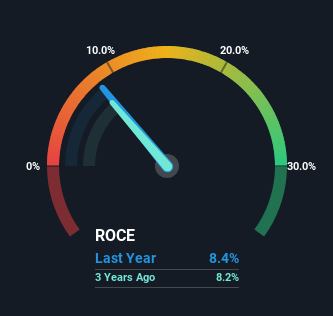- Hong Kong
- /
- Telecom Services and Carriers
- /
- SEHK:6823
The Returns At HKT Trust and HKT (HKG:6823) Aren't Growing

There are a few key trends to look for if we want to identify the next multi-bagger. Typically, we'll want to notice a trend of growing return on capital employed (ROCE) and alongside that, an expanding base of capital employed. Basically this means that a company has profitable initiatives that it can continue to reinvest in, which is a trait of a compounding machine. However, after investigating HKT Trust and HKT (HKG:6823), we don't think it's current trends fit the mold of a multi-bagger.
What Is Return On Capital Employed (ROCE)?
If you haven't worked with ROCE before, it measures the 'return' (pre-tax profit) a company generates from capital employed in its business. Analysts use this formula to calculate it for HKT Trust and HKT:
Return on Capital Employed = Earnings Before Interest and Tax (EBIT) ÷ (Total Assets - Current Liabilities)
0.084 = HK$7.7b ÷ (HK$112b - HK$20b) (Based on the trailing twelve months to December 2023).
Thus, HKT Trust and HKT has an ROCE of 8.4%. On its own that's a low return, but compared to the average of 6.2% generated by the Telecom industry, it's much better.
Check out our latest analysis for HKT Trust and HKT

In the above chart we have measured HKT Trust and HKT's prior ROCE against its prior performance, but the future is arguably more important. If you're interested, you can view the analysts predictions in our free analyst report for HKT Trust and HKT .
What The Trend Of ROCE Can Tell Us
Over the past five years, HKT Trust and HKT's ROCE and capital employed have both remained mostly flat. It's not uncommon to see this when looking at a mature and stable business that isn't re-investing its earnings because it has likely passed that phase of the business cycle. So don't be surprised if HKT Trust and HKT doesn't end up being a multi-bagger in a few years time. On top of that you'll notice that HKT Trust and HKT has been paying out a large portion (120%) of earnings in the form of dividends to shareholders. These mature businesses typically have reliable earnings and not many places to reinvest them, so the next best option is to put the earnings into shareholders pockets.
What We Can Learn From HKT Trust and HKT's ROCE
In a nutshell, HKT Trust and HKT has been trudging along with the same returns from the same amount of capital over the last five years. Unsurprisingly then, the total return to shareholders over the last five years has been flat. Therefore based on the analysis done in this article, we don't think HKT Trust and HKT has the makings of a multi-bagger.
On a final note, we found 2 warning signs for HKT Trust and HKT (1 can't be ignored) you should be aware of.
For those who like to invest in solid companies, check out this free list of companies with solid balance sheets and high returns on equity.
Valuation is complex, but we're here to simplify it.
Discover if HKT Trust and HKT might be undervalued or overvalued with our detailed analysis, featuring fair value estimates, potential risks, dividends, insider trades, and its financial condition.
Access Free AnalysisHave feedback on this article? Concerned about the content? Get in touch with us directly. Alternatively, email editorial-team (at) simplywallst.com.
This article by Simply Wall St is general in nature. We provide commentary based on historical data and analyst forecasts only using an unbiased methodology and our articles are not intended to be financial advice. It does not constitute a recommendation to buy or sell any stock, and does not take account of your objectives, or your financial situation. We aim to bring you long-term focused analysis driven by fundamental data. Note that our analysis may not factor in the latest price-sensitive company announcements or qualitative material. Simply Wall St has no position in any stocks mentioned.
About SEHK:6823
HKT Trust and HKT
An investment holding company, engages in the provision of technology, and satellite-and network-based telecommunications and related services in Hong Kong, Mainland China, and internationally.
Established dividend payer and good value.
Similar Companies
Market Insights
Community Narratives




